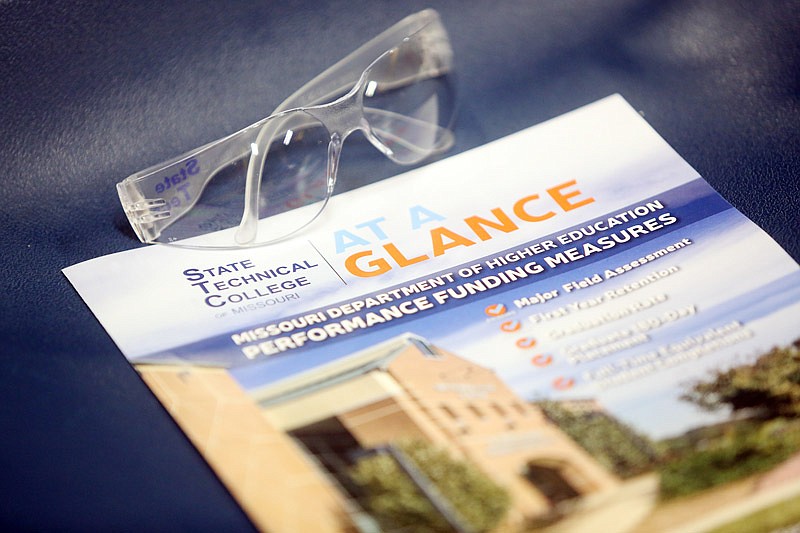LINN, Mo. - Unless it attracts 250 more students next year - a 20 percent growth - State Technical College of Missouri President Shawn Strong said, there will be layoffs and/or program cuts.
In a Friday presentation he called "Growing Our Way Out," Strong told the college's Industry Advisory Board: "If you talk to anybody in enrollment management and tell them you're going to grow your institution by 20 percent they'd say you're crazy.
"But that is what we're going to have to do - otherwise, we're going to face a (more than) $1.4 million shortfall."
State Tech has a budget deficit this year, too, Strong reported - but reserves are covering this year's hole.
"You can't use one-time money to fix an ongoing problem," he said. "That's what we're doing right now."
Strong said the technical college has room in all programs to handle the needed enrollment increase.
"If all of our programs are 90 percent full, we balance the budget," he said.
And the 2017-18 school year started well.
"Our freshman enrollment is up 8.3 percent," Strong reported. "The largest freshman class in our history.
"If you look at all the other two-year schools in the state, I believe there's one other school that's up - so we're bucking the trend."
Including State Tech, Missouri has 13 public two-year colleges, and another 10 four-year public universities, with 13 campuses.
Although Strong didn't report on the four-year schools, the same enrollment trend shows there, too.
Only three of the state's four-year campuses - Missouri Science and Technology, Rolla; Missouri State, Springfield; and Missouri Western, St. Joseph - have reported enrollment increases this year.
Admissions Director Shelly Jacobs noted State Tech attracted 692 freshmen this fall to set that new record, but added: "We need to increase that."
With the official census date in a week, administrators estimate this fall's total enrollment is 1,258 students.
Jacobs told the Advisory Board next year's goal is a total of 1,500 students.
Strong said State Tech also is finding ways to streamline the admissions process, including giving students credit for their prior learning or job experiences and letting qualified students enroll during - rather than at the beginning of - a semester.
Still, he said, State Tech has no intentions of diminishing its standards or admissions requirements.
"We need to get the right kind of students to apply to State Tech," Strong explained, "because the weakest of students out of high school we know aren't going to be successful here.
"If a kid's not coming out of high school with close to a 3.0 GPA, they're probably not going to make it.
"This is not an easy place - you have to want to work if you want to be a State Tech graduate."
Several new programs are being launched, such as the Utility Technicians classes that add telecommunications and broadband to the existing Electrical Distribution program.
There are consolidations of programs to the main campus, such as moving the nuclear program from Mexico, Missouri, to Linn - and new buildings, like the Health Sciences Center now under construction and expected to be occupied and operating next fall.
A new Welcome Center - a room in the Claycomb Information Technology Center outfitted with video screens - just opened to help visiting students and their families learn more about the school and its programs.
An ongoing branding campaign - including billboard, broadcast and print advertising, and social media contacts - aim to promote State Tech as "Missouri's premier technical college" and "the employers' choice" for finding recent graduates.
But, Strong said, word-of-mouth helps, as well.
He encouraged the Industry Advisory Board members to talk about the school to young people they know and to the high school counselors who work with those young people.
"We're finding that we need to work on our message with a lot of the high school counselors," Strong explained, "that State Tech - and technical college in general - shouldn't be a second-choice or a third-choice.
"It should be the first choice."
Studies show, he reported, "10 years after graduation, our students are going to be doing better (earning money) than somebody from a four-year regional school" like Missouri State or the University of Central Missouri, Warrensburg.
In an interview, Strong said neither a two-year school or a four-year school is the right place for everyone.
"There are so many options when it comes to higher education these days," he explained. "I think what we need to avoid is that a four-year degree should be for everybody.
"A two-year technical degree is a great option for a lot of students and probably students who may not be aware" of that.
Strong noted he began his own career with a two-year, technical school degree then later added bachelor's, master's and recently, a doctorate degree from four-year schools.
"I would say the best manager understands technical principles," he said. "If they understand both, they can be very, very valuable."

